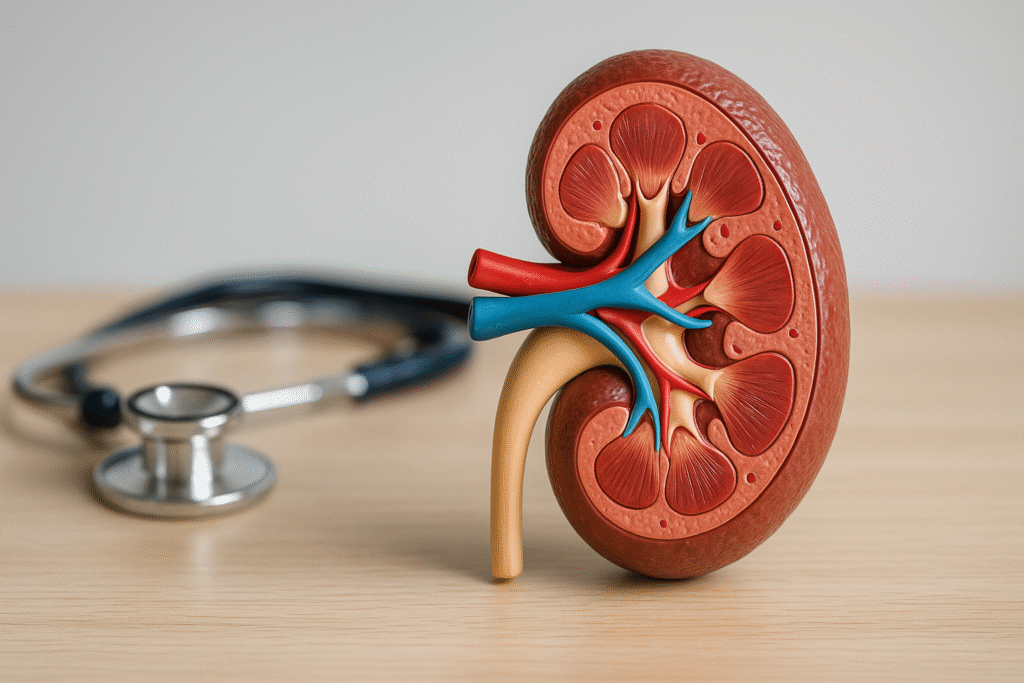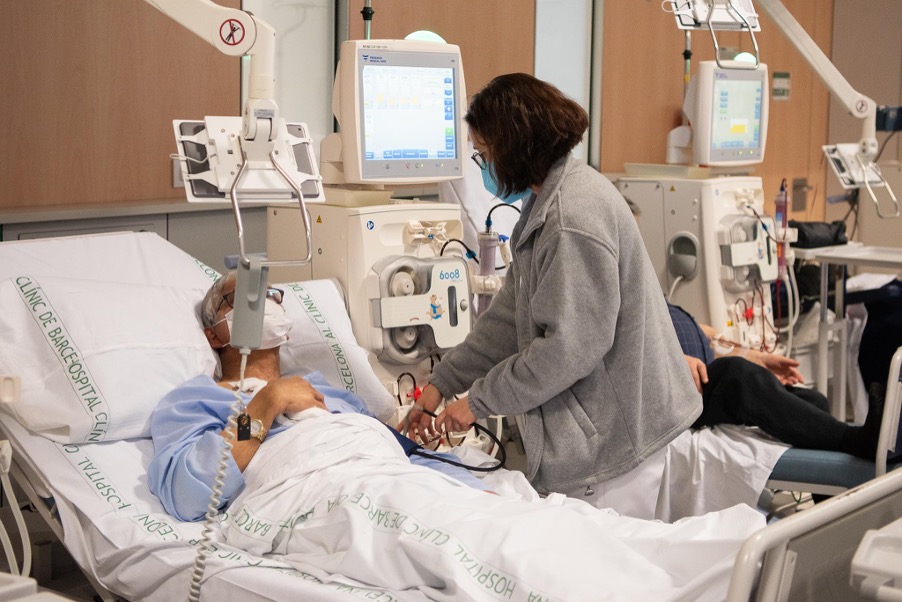
Small but mighty: your kidneys and the silent epidemic of chronic kidney disease

Imagine a disease that affects around 1 in 10 adults worldwide, yet most of those people don’t even realize they have it. This is the reality of chronic kidney disease (CKD), a progressive loss of kidney function that often flies under the radar. In 2021, CKD was estimated to impact 673 million people globally (over 8% of the world’s population) . It predominantly strikes older adults (about 20% of people over 55 have CKD) and is widely underdiagnosed . Health experts warn that CKD is a silent epidemic on the rise, projected to become the fifth leading cause of death in the world by 2050 . For context, CKD already rose from the 17th to the 10th leading cause of death between 1990 and 2020 . Yet, because it develops quietly, public awareness remains low.
Today marks the official launch of our social media awareness campaign, focused on the crucial topic of kidney disease prevention and, in this first article, we’ll explore why your kidneys, though small, are essential to your health, define what CKD is and its common causes, and explain why it often remains undetected until reaching advanced stages. Crucially, we’ll also highlight how early prevention and intervention can dramatically improve kidney health.
Kidneys: small but mighty organs
Your kidneys may be modest in size, each about the shape of a bean and the size of a fist, but they are powerhouse organs that perform a surprising array of life-sustaining jobs. Often called “small but mighty,” these two organs sit quietly in your lower back and keep you alive by performing critical balancing acts . Here are some of the vital functions your kidneys carry out every day :
- Filtering waste and toxins from the blood: Kidneys act as the body’s natural filtration system, removing waste products and toxins which are then excreted in urine. This keeps your blood clean and chemically balanced.
- Maintaining fluid and electrolyte balance: They regulate the amount of fluid in your body and the levels of key minerals (electrolytes) like sodium, potassium, calcium, and others. In doing so, kidneys also control blood pressure by adjusting how much water is excreted or retained . Think of them as the body’s internal “fluid thermostat,” ensuring you don’t retain too much water or dehydrate.
- Regulating acid-base (pH) and blood chemistry: Kidneys fine-tune the pH of your blood (how acidic or alkaline it is) so that your body’s enzymes and processes can work optimally . They also keep the balance of salts and other chemicals in check, preventing harmful buildups.
- Producing essential hormones: These organs aren’t just filters – they’re also factories for hormones. Kidneys release erythropoietin (EPO), a hormone that tells your bone marrow to produce red blood cells (preventing anemia) . They also produce renin, which helps regulate blood pressure, and Klotho, a hormone-protein that plays a role in healthy aging .
- Keeping bones healthy: Ever wonder how you get vitamin D? In fact, your kidneys activate vitamin D into its usable form . This activated vitamin D is crucial for absorbing calcium and phosphate, which means strong, healthy bones. Without properly working kidneys, bone health can suffer.
In short, your kidneys are multitasking heroes – blood purifiers, fluid balancers, chemical regulators, hormone producers, and bone protectors all in one. It’s no exaggeration to say that if your kidneys fail, almost every system in your body is affected. This is why protecting these small but mighty organs is essential for a healthy life.
What is chronic kidney disease (CKD)?
Chronic kidney disease refers to a lasting impairment in kidney structure or function. In medical terms, CKD is defined by abnormalities of the kidneys (in their structure or their functions) that persist for more than 3 months and have implications for a person’s health. In other words, if your kidneys are damaged or not working properly for at least 3 months, and this is not just a short-term (“acute”) issue, it is classified as CKD.
CKD isn’t one single illness but rather an umbrella term that includes any condition that causes gradual kidney damage over time – regardless of the original cause. Some people’s CKD is mild and progresses very slowly, while others may worsen to the point of kidney failure. The progression often depends on the underlying cause and how well it’s managed. Let’s take a look at the common causes of CKD.
Causes of CKD
There are many potential causes of chronic kidney disease. Some are due to primary kidney problems, while others stem from diseases affecting other parts of the body. The most common causes include3:
- Diabetes mellitus – Chronic high blood sugar from diabetes can damage blood vessels in the kidneys. In fact, diabetes is the number one cause of CKD worldwide.
- Hypertension (high blood pressure) – Uncontrolled high blood pressure and other cardiovascular diseases can impair kidney arteries and filtering units, leading to CKD.
- Glomerular diseases – Conditions that affect the kidney’s filtering units (glomeruli). These may be primary glomerular diseases (originating in the kidneys) or secondary to systemic illnesses. For example, certain autoimmune diseases attack the glomeruli.
- Congenital or hereditary disorders – Genetic conditions and birth defects can result in abnormal kidney structure or function (for instance, polycystic kidney disease is an inherited cause of CKD).
- Chronic interstitial nephritis – Diseases affecting the kidney’s tubules and surrounding tissues (the interstitium) can cause scarring over time. Chronic use of some medications or severe episodes of kidney inflammation can lead to this.
- Long-term urinary tract obstruction – Blockages in urine flow, such as from kidney stones (nephrolithiasis), tumors, or an enlarged prostate, can back up pressure and damage the kidneys if not relieved.
- Recurrent kidney infections – Frequent or inadequately treated kidney infections (pyelonephritis) or even recurrent lower urinary tract infections can cause scarring in the kidneys.
- Systemic diseases – Certain whole-body diseases often involve the kidneys. Examples include lupus (an autoimmune disease), vasculitis (blood vessel inflammation), and multiple myeloma (a blood cancer). These conditions can directly or indirectly injure kidney tissue.
As this list shows, CKD has diverse causes – from lifestyle-related diseases like diabetes and hypertension, to genetic disorders and autoimmune conditions. What they all have in common is that they can lead to a gradual, often irreversible loss of functioning kidney tissue.
The “silent disease”: why CKD often goes undetected
One of the most dangerous aspects of chronic kidney disease is how sneaky it is. In the early stages, CKD typically has no noticeable symptoms . You can lose a significant amount of kidney function and feel perfectly fine. In fact, a person can lose up to 90% of kidney function before experiencing any symptoms at all . That’s why CKD is sometimes dubbed a “silent killer.” Many people living with CKD have no idea their kidneys are in trouble until the disease is very advanced.
Why so silent? The kidneys have a remarkable reserve capacity – they can compensate when some parts are damaged, and the healthy parts do extra work. Additionally, the human body can tolerate a gradual accumulation of waste up to a point without obvious signs. Any mild symptoms that do appear (like slightly reduced energy or subtle changes in urination) are easy to overlook or attribute to other causes. Usually, CKD in its early stages is only detected if you happen to get routine blood or urine tests (for example, as part of an annual physical or while checking for something else) . These tests might show an elevated blood creatinine (a waste product) or protein leaking into the urine – clues that the kidneys are struggling – even though you feel fine.
As CKD progresses to more advanced stages, however, signs start to surface. Because these signs come late, they are often non-specific, meaning they could be mistaken for other illnesses. Some symptoms of advanced CKD include :
- Fatigue and weakness: As kidneys fail, anemia and toxin buildup can leave you feeling exhausted and weak.
- Changes in urination: Urine output may decrease substantially, or you might notice foamy urine (a sign of protein in urine) or blood in the urine. Some CKD patients report needing to urinate more often at night (nocturia) .
- Swelling (edema): Failing kidneys don’t effectively remove fluid, leading to swelling in the legs, ankles, or around the eyes.
- Loss of appetite, nausea, or vomiting: Waste buildup can cause gastrointestinal symptoms and a metallic taste in the mouth, making food unappealing. Weight loss can occur as a result.
- Itching and skin issues: High levels of toxins can cause itchiness (pruritus) or skin dryness.
- Shortness of breath: Fluid overload can cause fluid in the lungs or anemia can cause breathlessness.
- Confusion or difficulty concentrating: Very high toxin levels (uremia) affect mental function.
By the time such symptoms are noticeable, the kidneys are usually functioning at a fraction of their normal capacity. Indeed, “symptomatic CKD” often means the disease is advanced enough that kidney failure (end-stage disease) is either imminent or already present . As one public health source bluntly puts it, many people don’t know they have CKD until they’re hospitalized and told their kidneys are failing .
This is why early detection is so crucial – we want to catch CKD before symptoms arise. We’ll talk about early diagnosis later. Next, let’s look at what happens if CKD does reach its late stages.
Chronic kidney disease is both common and insidious. It creeps up without warning. Given its global prevalence and the lack of early symptoms, CKD deserves to be on everyone’s health radar.
Your kidneys are doing their part every day to keep you alive. Are you doing yours to keep them healthy?
In Part 2 of this series, we will explore what happens when CKD goes unchecked and progresses to later stages, and how we can fight back. We’ll discuss the serious consequences of late-stage CKD, effective strategies to prevent kidney disease, the importance of early diagnosis and treatment, and the role of innovative initiatives like KitNewCare in improving kidney health. Stay tuned for Part 2!
Learn more about CKD and its prevention here.


Save the date: Innovation Challenge 2 to accelerate sustainable kidney care across Europe

Green kidneys: solving nephrology’s climate paradox

